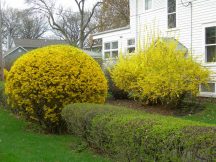Forsythia is familiar to almost everyone. You may not know the name of this spectacular bush, but its bright appearance is impossible to forget.
Material Content:
Shrub description
Forsythia is a medium-sized tree or shrub of the Maslin family, about 2 meters high. Some species of this plant reach a height of six meters, and babies less than a meter tall are also found.
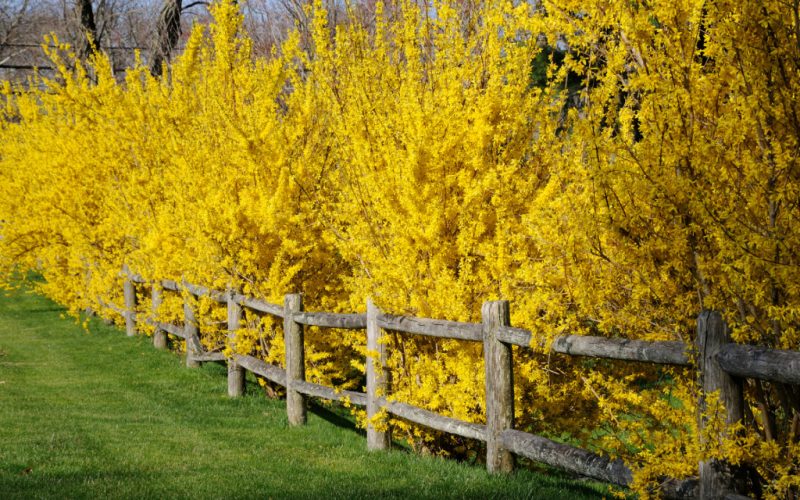
Forsythia leaves are simple or triple, oval in shape, with notches at the end, 2-15 cm long. In spring and summer, they have a saturated green color, in the fall, the color of most varieties changes. Foliage acquires burgundy, purple, violet, gold shades, it surprises with several bright colors of different intensities. Forsythia is particularly attractive in early spring. Even before the appearance of the leaves, the bushes become bright yellow due to the numerous flowers that cover the plant for 3–4 weeks with a continuous blanket.
After flowering, fruit-boxes with seeds are formed. For their appearance usually requires pollination of various plant forms.
Popular types and varieties
The genus Forsythia has 13 species, there are many varieties and hybrids of plants.
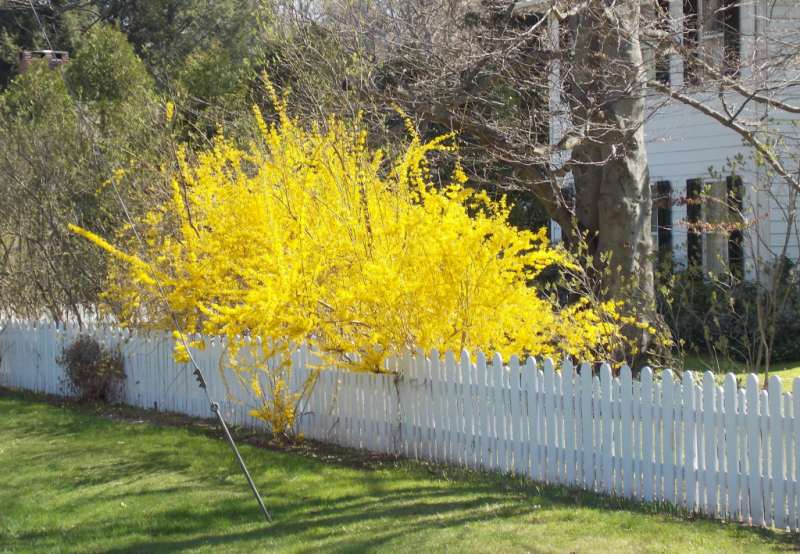
- The most common European Forsythia. The bush is about two meters tall with yellow bell flowers and elongated leaves about 5 - 7 cm.
- The drooping Forsythia has a drooping, sprawling crown. Its branches reach a length of 3 meters, and yellow flowers with a diameter of 2 - 2.5 cm are collected in small inflorescences.
- Forsythia is dark green - a large drought tolerant shrub up to 3 meters high.Some leaves reach 15 cm, and yellow flowers have a greenish tint.
- Intermediate - a hybrid of drooping and dark green. Parents gave the plant their best qualities: resistance to moisture and low temperatures, as well as a beautiful appearance. In this forsythia, the foliage retains an intense green color throughout the entire growing season. Based on this species, interesting varieties have been created. For example, Beatrix Farrand with inflorescences of light yellow hues and with a dark yellow border at the base of a flower bell.
- A distinctive feature of snow forsythia is white flowers with a yellow core. Its branches reach a length of 2 meters, and the leaves - about 8 cm.
- Oval is one of the most winter-hardy species up to 2 m high. It blooms a little earlier than others. Saturated green foliage becomes orange-crimson in the fall.
The plant for the site is selected taking into account the characteristics of the terrain. Prefer zoned species and varieties that have adapted to local weather conditions, topography and soil properties.
Features of Forsythia cultivation
The plant grows well even with minimal care. The beautiful appearance and excellent health of Forsythia is easier to maintain, given its tastes.
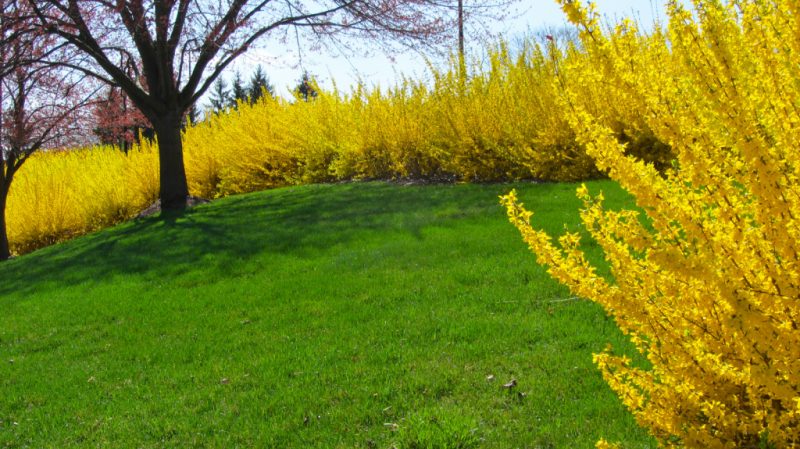
- Soil: light, without stagnation of water. Prefers calcareous soil. With increased acidity, wood ash or lime is added to the ground.
- Water regime: it is better to underfill than overfill. Tolerates waterlogging poorly. In hot and dry times, watered twice a month. An adult bush needs up to 15 liters of water for one irrigation. In rainy weather and in winter do not moisturize.
A lot of sun and moderate watering is the secret to successful Forsythia cultivation.
An unpretentious bush with yellow flowers will survive in partial shade, but flowering in this case will not be so plentiful. With significant shading, forsythia often gets sick, almost does not bloom.
Choosing a place and planting a plant in open ground

Suitable plot for landing Forsythia:
- light coloured;
- without drafts;
- closed from the winds.
Strong winds not only lead to mechanical damage. In the cold season, they reduce winter hardiness, and in the summer they quickly dry the land.
You can plant bushes in the open ground in spring or autumn. In spring, work is carried out when the threat of freezing the plant has passed. At the end of the growing season, planting dates are selected taking into account climatic features, so that the bush has time to take root before frost.
For landing Forsythia:
- They dig a hole, the length and width of which is about 50 cm, and the depth of about 60 cm.
- At the bottom there is a drainage layer, for example, of broken bricks.
- Then pour about 200 g of wood ash.
- Leaf soil is used as soil, adding sand and peat to it (ratio 2: 1: 1).
- After planting, slightly ground the soil around the plant and watered it.
If you need to plant several bushes, then it is advisable to make an interval between adjacent copies of at least 1.5 m.
How to care for shrubs
Forsythia needs the usual care for most plants. On the site with the plant, weeds are regularly removed, loosening and mulching is carried out. Also perform other work.
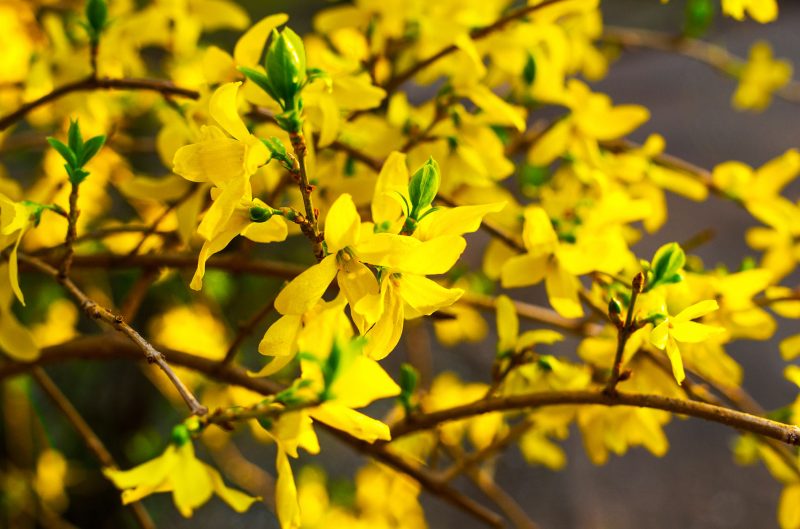
- Top dressing. During the growing season, the bush is fertilized. In the spring, organic and mineral dressings are used. For example, rotted manure is placed in the trunk circle at the beginning of the growing season and Kemira complex fertilizer (about 100 g per square meter of plantings) is applied after flowering.
- Pruning. In early spring, dry and damaged branches are removed. If necessary, carry out the formation: remove poorly located shoots, shorten too long. The healthy cuttings obtained during the work can be used for reproduction.
- Preparing for the winter. In the cold season, adult Forsythia shrubs can easily withstand cold under a layer of snow. Young seedlings under 5 years old require shelter. In regions with little snow, the amount of winter rainfall is difficult to predict, so the plant is covered with a layer of dry leaves or spruce branches regardless of age before frost.
Forsythia propagation methods
Get new plant instances using cuttings. Forsythia is also propagated by seeds and layering.
Seeds
This option is used to get a lot of young plants. It will take a lot of time and effort, and the young growth obtained may differ from the mother liquor in various ways.
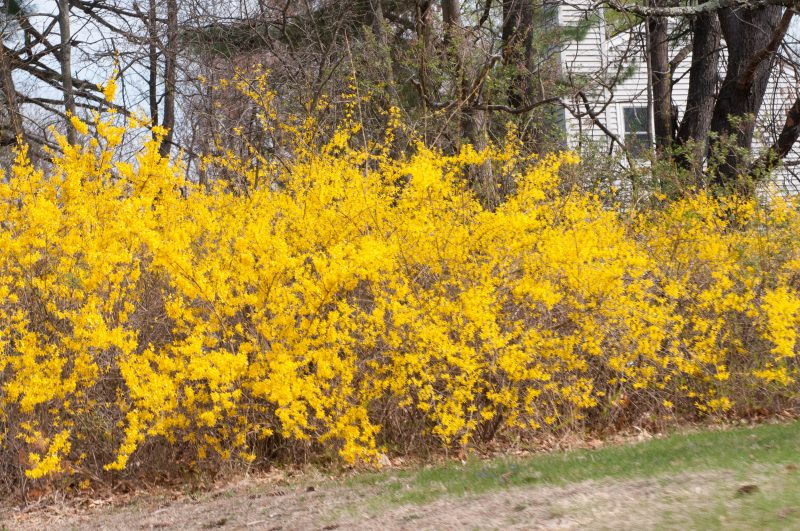
The seed propagation method is appropriate to apply if there is a desire to pollinate different species and get a plant with unique properties.
- Seeds are harvested after ripening, usually in October.
- In winter, they are stratified. For this, the seed material can withstand from 1.5 to 2.5 months at a temperature of 2 - 5 degrees heat.
- It is best to sow in March - April in specially prepared containers.
- For soil, take a mixture of humus and sand in a ratio of 2: 1.
- Crops are covered with a film of polyethylene and contain at room temperature. They are moistened, loosened, aired. It takes a month for the first shoots to appear.
- After that, the covering material is removed, during the year they regularly take care of young plants.
- Next spring, the seedlings reach a size of about 8 cm, and it is time to dive. Can be planted immediately at a permanent place of cultivation or placed in a larger container.
- In a year, the bushes will already be about 20 cm, and at the age of three they will grow up to about 80 cm. Young growth must be covered with a thick layer of leaves for the winter.
- The first flowering is possible at the age of 4 - 5 years.
Layering
You can form layers from a branch that grows on a bush close to the soil surface.

Sometimes such a shoot roots itself if it comes into contact with the soil surface.
Rooting work is carried out both in the spring and in the fall.
- In the area of the branch that is in contact with the soil, a bark is cut.
- The shoot is pressed against the surface of the earth and slightly deepened into the soil.
- Fix the layering in the desired position using a wire. The layering is watered from time to time, and for the winter it is insulated with a layer of dry foliage or spruce branches.
- The plant is planted in early or mid-autumn of next year. In this case, the young Forsythia will have time to take root in a new place before the frost.
Cuttings
- At the beginning of summer, green shoots 13-16 cm long are cut.
- The lower leaflets are torn off on them, and the section is treated with a root stimulant, for example, “Kornevin”.
- Cuttings are planted in the sand, covered with a film of polyethylene. They are protected from direct sunlight, regularly watered, ventilated, weed area with plantings. With good care, the percentage of rooted plants is very high.
- In winter, young growth must be carefully covered with dry foliage, and watering is stopped. Forsythia grown in this way bloom at the age of 2 to 3 years.
In addition to green shoots, for propagation, you can use lignified branches.
They are harvested and planted in the fall in autumn, around October. Above the surface of the earth place a pair of kidneys. Before frosts, young plantings are covered with dry foliage.
Protection against diseases and pests
Under favorable living conditions, forsythia is rarely damaged by diseases and pests.
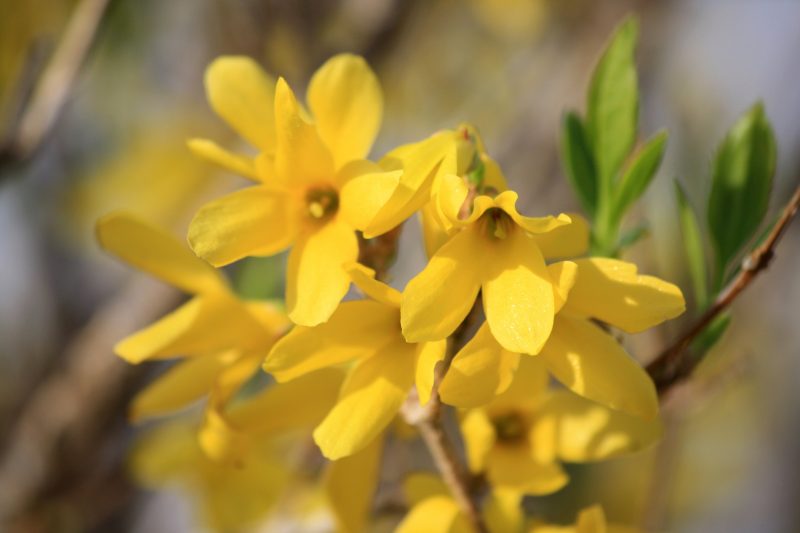
- The cause of fungal diseases may be waterlogging, significant shading of the site, poor quality soil or infected neighboring plants. Damaged branches of the disease are removed.
- To combat powdery mildew, the culture is sprayed with Bordeaux liquid.
- To defeat the wilting of leaves will help "Fundazol".
The most common parasites that can be found in Forsythia are aphids and nematodes. The fight against aphids is carried out immediately after its detection. Small colonies of pests can be neutralized with soapy water or by dusting with ash. If there are a lot of parasites, spray the plant with an insecticide according to the instructions.
The presence of nematodes in the soil can be suspected if, with good care, forsythia grows poorly, some branches dry out for no reason. It is necessary to process the trunks circles "Nemaphos" or another drug against nematodes.
Forsythia in landscape design
A bright and unpretentious shrub is used to decorate public and home flower gardens.
- Forsythia is appropriate to plant on the slopes or create a hedge from it.
- Some varieties and hybrids are grown as a pot culture.
- The standard form of the plant looks original.
- In landscape design, the plant is suitable for single and group planting, harmoniously combined with roses, conifers, many perennials.
Forsythia is a yellow shrub whose flowering helps to feel the arrival of spring. It looks very decorative at different times of the year: in spring, bright yellow flowers will present a sunny mood, in autumn, colorful foliage of amazing colors will decorate the site.



